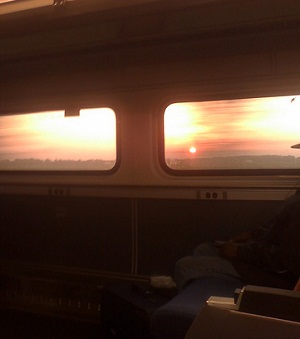Happening Now
“Praising and Pushing” for a Rejuvenated Chicago-St. Louis Corridor
January 29, 2013
Written By Malcolm Kenton
To be an effective advocate, one must both praise and push—praise the steps that are being taken in the right direction, but at the same time push decisionmakers to kick it up a notch. There is still a significant gap between what is being done and what needs to be done for Americans to maintain our mobility and prosperity into the 21st century. NARP Director and Midwest High-Speed Rail Association President Rick Harnish effectively balances praising and pushing in a St. Louis Post-Dispatch column published on Wednesday.

Current plans call for the existing Chicago-St. Louis rail corridor to be double-tracked and top train speeds to be brought to 110 mph over much of the route. This brings end-to-end travel time down to 4 hours, makes trains much more reliable, and allows additional train frequencies to be implemented. This will make for a significant boon to travelers and local economies along this busy corridor that suffers from both road and air congestion—and NARP is doing what we can to see this plan carried to fruition. But it won’t truly transform the travel market the way an electrified high-speed line would.
Excerpts from Harnish’s column:
True high-speed trains, using proven technology, could slash the St. Louis to the Chicago Loop trip to just 90 minutes, with hourly departures. If existing rail infrastructure were blended with long segments of new high-speed construction, similar to what is being done in California, trains could easily beat the 2.5-hour travel time needed to truly change today’s journey into a commute. The same trains could stop at both downtown and Lambert, creating new opportunities for more people to take advantage of the reduced costs and improved access created by fast trains.
In truth, we’re not just talking about a train. We’re talking about an economic powerhouse. A truly modern rail system, beginning with the proposed new Chicago/St. Louis line, can become the driver of economic development throughout the nation’s heartland and beyond. From an environmental standpoint it can be a huge “win,” diminishing our dependence on fossil fuels and helping to reduce air and auto emissions. Above all, this line can become the anchor of a modern transport web linking the big cities of the Midwest, and incubating new enterprises along its path.
The St. Louis-Chicago project will span a big stretch of the nation’s economic engine — the heartland of steel production, Midwest coal production, varied manufacturing and agricultural.
We need high-speed rail to support the new economic drivers of today’s Midwest: commerce, information technology, medical research and high-tech manufacturing. The high-speed rail project itself will be a generator of new jobs, breathing new energy into surrounding communities — especially if we take the time to engage the leaders from Missouri, Illinois and the federal transportation authorities in meaningful planning. The plan should demonstrate a great and immediate benefit to intermediate cities between Chicago and St. Louis, and eventually become the hub of a web that includes Detroit, Milwaukee, Cleveland and other cities in need of this economic kick-start.
…
A project of this size would require a combined public/private investment, with federal, state and local governments providing proportionate shares of the cost. This is far from the first time such a mixed investment project will be undertaken, but it will take time to put together the pieces. That is why it is critical to get started now.
And we can take the first concrete step right now. Soon, the Illinois Department of Transportation will begin designing a new railroad bridge over the Mississippi. Let’s make sure that it is designed to carry the true high-speed trains that we desperately need.
"It is an honor to be recognized by the Rail Passengers Association for my efforts to strengthen and expand America’s passenger rail. Golden spikes were once used by railroads to mark the completion of important rail projects, so I am truly grateful to receive the Golden Spike Award as a way to mark the end of a career that I’ve spent fighting to invest in our country’s rail system. As Chair of the Transportation and Infrastructure Committee, it has been my priority to bolster funding for Amtrak, increase and expand routes, look to the future by supporting high-speed projects, and improve safety, culminating in $66 billion in new funding in the Bipartisan infrastructure Law."
Representative Peter DeFazio (OR-04)
March 30, 2022, on receiving the Association's Golden Spike Award for his years of dedication and commitment to passenger rail.
Comments